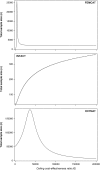A new approach for sample size calculation in cost-effectiveness studies based on value of information
- PMID: 30348087
- PMCID: PMC6198488
- DOI: 10.1186/s12874-018-0571-1
A new approach for sample size calculation in cost-effectiveness studies based on value of information
Abstract
Background: Value of information is now recognized as a reference method in the decision process underpinning cost-effectiveness evaluation. The expected value of perfect information (EVPI) is the expected value from completely reducing the uncertainty surrounding the cost-effectiveness of an innovative intervention. Among sample size calculation methods used in cost-effectiveness studies, only one is coherent with this decision framework. It uses a Bayesian approach and requires data of a pre-existing cost-effectiveness study to derive a valid prior EVPI. When evaluating the cost-effectiveness of innovations, no observed prior EVPI is usually available to calculate the sample size. We here propose a sample size calculation method for cost-effectiveness studies, that follows the value of information theory, and, being frequentist, can be based on assumptions if no observed prior EVPI is available.
Methods: The general principle of our method is to define the sampling distribution of the incremental net monetary benefit (ΔB), or the distribution of ΔB that would be observed in a planned cost-effectiveness study of size n. Based on this sampling distribution, the EVPI that would remain at the end of the trial (EVPIn) is estimated. The optimal sample size of the planned cost-effectiveness study is the n for which the cost of including an additional participant becomes equal or higher than the value of the information gathered through this inclusion.
Results: Our method is illustrated through four examples. The first one is used to present the method in depth and describe how the sample size may vary according to the parameters' value. The three other examples are used to illustrate in different situations how the sample size may vary according to the ceiling cost-effectiveness ratio, and how it compares with a test statistic-based method. We developed an R package (EBASS) to run these calculations.
Conclusions: Our sample size calculation method follows the value of information theory that is now recommended for analyzing and interpreting cost-effectiveness data, and sets the size of a study that balances its cost and the value of its information.
Keywords: Clinical trials; Comparative studies; Cost-benefit analysis; Epidemiologic methods; Sample size; Value of information.
Conflict of interest statement
Ethics approval and consent to participate
Not applicable
Consent for publication
Not applicable
Competing interests
The authors declare that they have no competing interests.
Publisher’s Note
Springer Nature remains neutral with regard to jurisdictional claims in published maps and institutional affiliations.
Figures



Similar articles
-
Uncertainty and the Value of Information in Risk Prediction Modeling.Med Decis Making. 2022 Jul;42(5):661-671. doi: 10.1177/0272989X221078789. Epub 2022 Feb 25. Med Decis Making. 2022. PMID: 35209762 Free PMC article.
-
Two-level resampling as a novel method for the calculation of the expected value of sample information in economic trials.Health Econ. 2013 Jul;22(7):877-82. doi: 10.1002/hec.2869. Epub 2012 Aug 30. Health Econ. 2013. PMID: 22933363
-
When is enough evidence enough? - Using systematic decision analysis and value-of-information analysis to determine the need for further evidence.Z Evid Fortbild Qual Gesundhwes. 2013;107(9-10):575-84. doi: 10.1016/j.zefq.2013.10.020. Epub 2013 Nov 12. Z Evid Fortbild Qual Gesundhwes. 2013. PMID: 24315327 Review.
-
Estimating Value-Based Price and Quantifying Uncertainty around It in Health Technology Assessment: Frequentist and Bayesian Approaches.Med Decis Making. 2022 Jul;42(5):672-683. doi: 10.1177/0272989X221079554. Epub 2022 Feb 16. Med Decis Making. 2022. PMID: 35172648
-
Sample size determination for cost-effectiveness trials.Pharmacoeconomics. 2011 Nov;29(11):933-49. doi: 10.2165/11587130-000000000-00000. Pharmacoeconomics. 2011. PMID: 21988292 Review.
Cited by
-
Cost-effective analysis focused on hypoglycemia of intermittent-scanning continuous glucose monitoring in type 1 diabetes adults: a ISCHIA randomized clinical trial.Diabetol Int. 2024 Oct 16;16(1):78-85. doi: 10.1007/s13340-024-00762-1. eCollection 2025 Jan. Diabetol Int. 2024. PMID: 39877450
-
Is intraoperative ultrasound more efficient than magnetic resonance in neurosurgical oncology? An exploratory cost-effectiveness analysis.Front Oncol. 2022 Oct 28;12:1016264. doi: 10.3389/fonc.2022.1016264. eCollection 2022. Front Oncol. 2022. PMID: 36387079 Free PMC article.
-
The Polygenic Nature of Multiple Sclerosis: Genetic Variants, Immunological Modulation, and Environmental Connections.Endocr Metab Immune Disord Drug Targets. 2025;25(7):527-559. doi: 10.2174/0118715303325979241206115417. Endocr Metab Immune Disord Drug Targets. 2025. PMID: 39810445 Review.
-
Effectiveness of Kushal Maa, a group-based mhealth interactive education and social support intervention for maternal and neonatal health outcomes: study protocol for a multisite randomised controlled trial in India.BMJ Open. 2025 Jun 27;15(6):e104213. doi: 10.1136/bmjopen-2025-104213. BMJ Open. 2025. PMID: 40578858 Free PMC article.
-
Appropriate design and reporting of superiority, equivalence and non-inferiority clinical trials incorporating a benefit-risk assessment: the BRAINS study including expert workshop.Health Technol Assess. 2023 Oct;27(20):1-58. doi: 10.3310/BHQZ7691. Health Technol Assess. 2023. PMID: 37982521 Free PMC article.
References
-
- Raiffa H, Schlaifer R. Applied Statistical Decision theory. Boston: Harvard University Press; 1961.
MeSH terms
LinkOut - more resources
Full Text Sources

